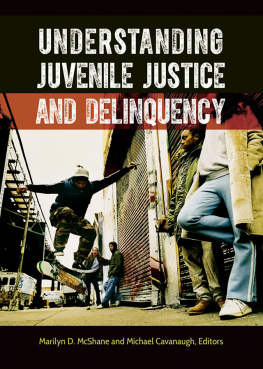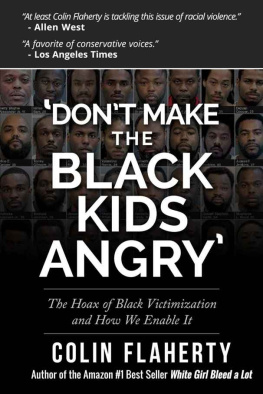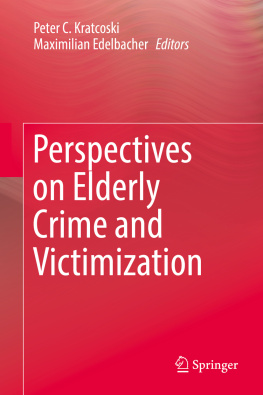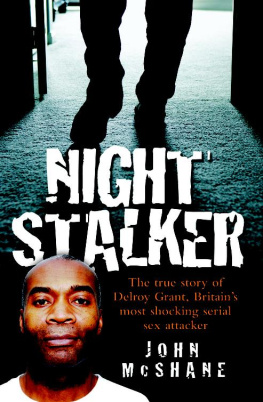Introductions copyright 1997 Marilyn McShane and Frank P. Williams III. All rights reserved.
First published 1997 by Garland Publishing, Inc.
This edition published 2013 by Routledge
711 Third Avenue, New York, NY 10017
2 Park Square, Milton Park, Abingdon, Oxon, OX14 4RN
Routledge is an imprint of the Taylor & Francis Group, an informa business
Library of Congress Cataloging-in-Publication Data
Victims of crime and the victimization process / edited with introductions by Marilyn McShane and Frank P. Williams III.
p. cm. (Criminal justice ; v. 6)
Includes bibliographical references.
ISBN 0-8153-2513-4 (alk. paper)
1. Victims of crimesUnited States. I. McShane, Marilyn D., 1956 . II. Williams, Franklin P. III. Series: Criminal justice (New York, N.Y.) ; v. 6.
HV6250.3.U5V35 1997
At the turn of the century the criminal justice system will be confronting many of the same demons, although the drugs of choice, the technology of crime fighting, and the tools and techniques of management have evolved. Despite the enhancements of twenty-first century technologies, funding, crowding, and public concerns about effectiveness continue to be discussed in crisis terminology, and criminal justice scholars remain somewhat cynical about the ability to reform the criminal justice system. This pessimistic attitude may be fueled, at least in part, by the drama of real-life crime that plays itself out in courtrooms, newspapers, and talk shows across America every day. The combination of emotional political maneuvering and campaigning on punitive rhetoric assures us of a steady stream of legislation designed to reflect a zero tolerance for crime.
Testing the constitutional limits of our times, we have devised even more ways of imposing severe punishments, seizing assets, reinstituting corporal punishment, and penalizing the parents of delinquents. We have also created new offenses, such as recruiting someone into a gang, transmitting indecent images on the Internet, and knowingly passing along a disease. Despite these politically popular solutions to crime, problems of enforcement, equity, and affordability remain. The publics preoccupation with what works? and quick fixes to crime problems have never been reconciled with the more realistic ideas of what can we live with? and long-range preventive solutions.
Ironically, despite public perceptions that crime has been getting worse, statistics seem to indicate that the rates for virtually all offenses are either no worse than they were in 1980 or are now lower. Drug-related arrests and the rates for most forms of adult crime (in particular, most violent crimes) have actually decreased. Against this general backdrop, the rate of violent juvenile crime appears to be the sole increasing trend, leading to a situation in which risks of victimization by violent crime have also increased for juveniles. The contrary public perception of a massive and growing crime problem has created a situation in which the number of cases of juveniles transferred to adult court has increased, as has the proportion of inmates facing life sentences, life in prison without parole, and death sentences. On the other hand the risk of incarceration also appears to have increased for minorities, directing attention to questions of racial and economic disparity in the quality of protection and justice available in this country today.
While all this has been happening over the past two decades, academia has rather quietly developed an entire discipline dedicated to the study of crime and the criminal justice system. Though crime policy is still dominated largely by political interests swayed by public opinion, crime scholars have begun to have an impact on how crime is viewed and what can be done about it. While this impact is not yet a major one, it continues to gain weight and shows promise of some day achieving the influence that economists have come to wield in the realm of public policy-making.
Simultaneously with this growing scholarship comes an irony: academic journals, the major repository of scholarly wisdom, are being discontinued by libraries. Access, although ostensibly available in an electronic form, is decreasing. In many academic libraries, only a few select, major journals are being retained. Clearly, there is so much being done that the few top journals cannot adequately represent current developments (even if these journals were not focused in particular directions). Thus, the knowledge of the field is being centralized and, at the same time, more difficult to obtain. The multitude of criminal justice and criminology degree programs now face an interesting dilemma: how do students and faculty access current information? Or put differently, how does the field distribute its hard-gained knowledge to both assure quality of education and pursue efforts to offset the often ill-informed myths of public opinion?
Electronic access would appear to be one possible answer to the problem, especially with libraries facing yet another squeeze, that of space. On-line and media-based (CD-ROM) services promise quick availability of periodical literature, but remain futuristic. The costs associated with downloading articles can approximate the cost of the journal subscriptions themselves and many libraries cannot afford to participate in on-line periodical services. In addition, there is the inconvenience of translating the electronic images into the users still-preferred paper-based format. Moreover, the paper-based serendipitous value of browsing decreases as only specific articles appear online, without surrounding materials.
An alternative solution is to review the range of journals and collect the best of their articles for reprinting. This is the approach this criminal justice periodical series has taken. By combining both depth and scope in a series of reprints, the series can offer an attractive, cost-effective answer to the problem of creating access to scholarship. Moreover, such a compact format yields the added advantage that individuals searching for a specific topic are more likely to experience the serendipity of running across related articles. Each of the six volumes presents a comprehensive picture of the state of the art in criminal justice today and each contains articles focused on one of the major areas of criminal justice and criminology: Police, Drugs, Criminological Theory, Corrections, Courts, and Victimology. Each volume contains approximately twenty articles.
The Article Selection Process
The articles appearing in the series represent the choices of the editors and a board of experts in each area. These choices were based on four criteria: (1) that the articles were from the time period of 19911995, (2) that they represent excellent scholarship, (3) that collectively they constitute a fair representation of the knowledge of the period, and (4) that where there were multiple choices for representing a knowledge area, the articles appeared in journals that are less likely to be in todays academic library holdings. We believe the selection criteria and the board of experts were successful in compiling truly representative content in each topical area. In addition, the authors of the selected articles constitute a list of recognizable experts whose work is commonly cited.








